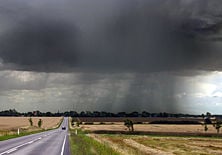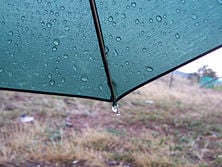Rain
 From Nwe
From Nwe 
Rain is a form of precipitation—other forms of which include snow, sleet, and hail. Rain forms when separate drops of water fall to the Earth's surface from clouds. Not all rain reaches the surface, however—some evaporates while falling through dry air. When none of it reaches the ground, it is called virga, a phenomenon often seen in hot, dry desert regions. The scientific explanation of how rain forms and falls is called the Bergeron process.
Rain in nature

Rain plays a role in the hydrologic cycle in which moisture from the oceans evaporates, condenses into clouds, precipitates back to earth, and eventually returns to the ocean via streams and rivers to repeat the cycle again. There is also a small amount of water vapor that respires from plants and evaporates to join other water molecules in condensing into clouds.
The amount of rainfall is measured using a rain gauge. It is expressed as the depth of water that collects on a flat surface, and can be measured to the nearest 0.27 mm or 0.01 inch. It is sometimes expressed in litres per square metre (one liter/m² = one mm).
Falling raindrops are often depicted in cartoons or anime as "teardrop-shaped"—round at the bottom and narrowing towards the top—but this is incorrect. Only drops of water dripping from some sources are tear-shaped at the moment of formation. Small raindrops are nearly spherical. Larger ones become increasingly flattened on the bottom, like hamburger buns; very large ones are shaped like parachutes.[1] The shape of raindrops was studied by Philipp Lenard in 1898. He found that small raindrops (less than about two mm in diameter) are approximately spherical. As they get larger (to about five mm in diameter) they become more doughnut-shaped. Beyond about 5 mm they become unstable and fragment. On average, raindrops are one to two mm in diameter. The biggest raindrops on Earth were recorded over Brazil and the Marshall Islands in 2004—some of them were as large as ten mm. The large size is explained by condensation on large smoke particles or by collisions between drops in small regions with particularly high content of liquid water.
Raindrops impact at their terminal velocity, which is greater for larger drops. At sea level and without wind, 0.5 mm rain drizzle impacts at about two m/s, while large five mm drops impact at around nine m/s.
Generally, rain has a pH slightly under six. This is because atmospheric carbon dioxide dissolves in the droplet to form minute quantities of carbonic acid, which then partially dissociates, lowering the pH. In some desert areas, airborne dust contains enough calcium carbonate to counter the natural acidity of precipitation, and rainfall can be neutral or even alkaline. Rain below pH 5.6 is considered acid rain.
Rain is said to be heavier immediately after a bolt of lightning. The cause of this phenomenon is traceable to the bipolar aspect of the water molecule. The intense electric and magnetic field generated by a lightning bolt forces many of the water molecules in the air surrounding the stroke to line up. These molecules then spontaneously create localized chains of water (similar to nylon or other "poly" molecules). These chains then form water droplets when the electric/magnetic field is removed. These drops then fall as intensified rain.
Effect on agriculture
Precipitation, especially rain, has a dramatic effect on agriculture. All plants need at least some water to survive, therefore rain (being the most effective means of watering) is important to agriculture. While a regular rain pattern is usually vital to healthy plants, too much or too little rainfall can be harmful, even devastating to crops. A Drought can kill crops in massive numbers, while overly wet weather can cause disease and harmful fungus. Plants need varying amounts of rainfall to survive. For example, cacti need small amounts of water while tropical plants may need up to hundreds of inches of rain to survive.
Human influence
The fine particulate matter produced by car exhaust and other human sources of pollution form cloud condensation nuclei, leading to the production of clouds and increasing the likelihood of rain. As commuters and commercial traffic cause pollution to build up over the course of the week, the likelihood of rain increases—it peaks by Saturday, after five days of weekday pollution has been built up. In heavily populated areas that are near the coast, such as the United States' Eastern Seaboard, the effect can be dramatic—there is a 22 percent higher chance of rain on Saturdays than on Mondays.[2]
Culture

Cultural attitudes towards rain differ across the world. In the largely temperate Western world, rain metaphorically has a sad and negative connotation, reflected in children's rhymes like Rain Rain Go Away, in contrast to the bright and happy sun. Though the traditional notion of rain in the Western World is negative, rain can also bring joy, as some consider it to be soothing or enjoy the aesthetic appeal of it. In dry places, such as parts of Africa, India, and the Middle East, rain is greeted with euphoria. (In Botswana, the Setswana word for rain, "pula," is used as the name of the national currency, in recognition of the economic importance of rain in this desert country.)
Several cultures have developed means of dealing with rain and have developed numerous protection devices such as umbrellas and raincoats, and diversion devices such as |gutters and storm drains that lead rains to sewers. Many people also prefer to stay inside on rainy days, especially in tropical climates where rain is usually accompanied by thunderstorms or when rain is extremely heavy (monsoon). Rain may be harvested, though rainwater is rarely pure (as acid rain occurs naturally), or used as greywater. Excessive rain, particularly after a dry period has hardened the soil so that it cannot absorb water, can cause floods.
Many people find the scent during and immediately after rain especially pleasant or distinctive. The source of this scent is petrichor, an oil produced by plants, then absorbed by rocks and soil, and later released into the air during rainfall. Light, or sometimes heavy rain is sometimes also seen as romantic. Rain can also and always will be to some people very depressing due to bleak clouds.
A country noted for its rainy nature is the United Kingdom. The reputation is partly deserved because of the frequency of rain driven into the country by the south-western trade winds following the warm gulf stream currents. Areas along the western coasts (including those in Ireland) can receive between 40 inches (sea-level) and 100 inches (mountains) of rain per year. However, what is less well known is that the eastern and southern half of the country is much drier, with the south-east having a lower rainfall average than Jerusalem and Beirut at between 450 and 600 mm per year.
One city that is known for rain is Seattle, Washington, United States. Rain is common in the winter, but mostly the climate is cloudy with little rain. Seattle's average rainfall is 37.1 inches (942 mm) per year,[3] less than New York City with 46.2 inches (1173 mm),[4] but has 201 cloudy days per year (compared to 152 in New York).[5] However, it should be noted that Seattle lies in the rain shadow of the nearby Olympic Mountains, with some locations on the windward sides of the mountains receiving close to 200 inches (5080 mm) per year.[6]
Vancouver, British Columbia could be considered the world's capital of rain, despite having some snow during special periods, receiving as much as 40 mm at one time. Almost every day in the winter the Greater Vancouver Area is plummeted by rain. Rain is hated in Vancouver by many residents, though they still tend to live there because the sky is usually sunny during the Summer.
Melbourne, Australia has a similar reputation, in comparison to Sydney, Australia—however, Sydney receives an average of 43.1 inches (1094 mm) of rain per year[7] compared to Melbourne's 21.4 inches (544 mm).[8] Sydney, meanwhile, experiences 53 fewer overcast days per year than Melbourne.[7][8]
References
ISBN links support NWE through referral fees
- ↑ http://www.ems.psu.edu/~fraser/Bad/BadRain.html Retrieved April 17, 2007.
- ↑ Cerveny, R. S., and R. C. Balling. Weekly cycles of air pollutants, precipitation and tropical cyclones in the coastal NW Atlantic region. Nature. 394, 561-563. Retrieved April 17, 2007.
- ↑ Monthly Averages for Seattle, WA. The Weather Channel. Retrieved April 17, 2007.
- ↑ Monthly Averages for New York, NY. The Weather Channel. Retrieved April 17, 2007.
- ↑ Cloudiness - Mean Number of Days. National Climatic Data Center. Retrieved April 17, 2007.
- ↑ Average Annual Precipitation in Washington. Oregon Climate Service at Oregon State University. Retrieved April 17, 2007.
- ↑ 7.0 7.1 Averages for SYDNEY AIRPORT AMO. Australian Government Bureau of Meteorology. Retrieved April 17, 2007.
- ↑ 8.0 8.1 Averages for MELBOURNE AIRPORT. Australian Government Bureau of Meteorology. Retrieved April 17, 2007.
See also
- Acid rain
- Cloud
- Red rain in Kerala
- Water cycle
- Water resources
- Weather
External links
All links retrieved December 7, 2022.
- What are clouds, and why does it rain?
- BBC article on the weekend rain effect
- BBC article on rain-making
Credits
New World Encyclopedia writers and editors rewrote and completed the Wikipedia article in accordance with New World Encyclopedia standards. This article abides by terms of the Creative Commons CC-by-sa 3.0 License (CC-by-sa), which may be used and disseminated with proper attribution. Credit is due under the terms of this license that can reference both the New World Encyclopedia contributors and the selfless volunteer contributors of the Wikimedia Foundation. To cite this article click here for a list of acceptable citing formats.The history of earlier contributions by wikipedians is accessible to researchers here:
- Rain history
The history of this article since it was imported to New World Encyclopedia:
- History of "Rain"
Note: Some restrictions may apply to use of individual images which are separately licensed.
↧ Download as ZWI file | Last modified: 02/03/2023 20:53:26 | 50 views
☰ Source: https://www.newworldencyclopedia.org/entry/Rain | License: CC BY-SA 3.0
 ZWI signed:
ZWI signed:
 KSF
KSF